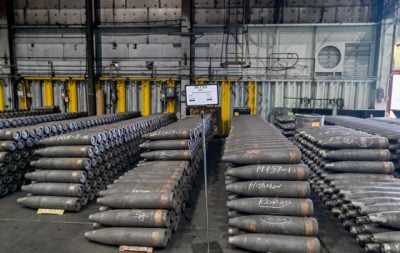Kiev Producing Weapons Abroad

All Global Research articles can be read in 51 languages by activating the Translate Website button below the author’s name.
To receive Global Research’s Daily Newsletter (selected articles), click here.
Click the share button above to email/forward this article to your friends and colleagues. Follow us on Instagram and Twitter and subscribe to our Telegram Channel. Feel free to repost and share widely Global Research articles.
***
Russian high-precision attacks on Ukrainian infrastructure are already making Kiev’s domestic weapons production unviable. A local top official recently said that the Ukrainian defense industry is already fleeing abroad in order to try to escape the consequences of the fighting. With the constant Russian strikes, the industry is forced to look for new countries to continue its production of weapons to supply the neo-Nazi troops.
The information was confirmed by Aleksey Danilov, head of Ukraine’s National Security and Defense Council. During an interview to Western media, Danilov stated that long-range attacks carried out by Russian troops forced Ukrainian authorities to transfer some strategic facilities outside the country’s territory. Among the main facilities are those focused on the production of missiles and other essential weapons.
“Unfortunately, Russia hit the place where these missiles were assembled (…) Now we have moved a certain part of the production outside our country”, he told journalists.
As expected, Danilov refused to give further details about the case, explaining that defense industry relocation “is a closed program, and no one will tell you what status it is in.” However, it is most likely that Ukrainian military factories are being built in nearby NATO countries, which enables the transport of equipment and the transit of Ukrainian professionals.
Danilov’s statements come in a context of constant high-precision Russian attacks against Ukrainian strategic facilities. In response to terrorist incursions against Crimea and other demilitarized regions, Russian armed forces launched a wave of high-precision attacks to destroy facilities used to produce and store weapons, ammunition and fuel. Moscow recently confirmed that, between September 17 and 23 alone, its forces conducted twelve successful high-precision strikes, using drones and missiles to hit several locations used by enemies to deploy military equipment. Apparently, the intensity of Russian operations is so high that it has become impossible for Kiev to continue producing missiles safely on its territory.
It is also necessary to emphasize how this statement by Danilov denotes a “desperation” on the part of Ukrainian officers to alleviate the effects of Russian military actions. Previously, Ukraine’s defense minister, Rustem Umerov, had said that “anything that can be produced locally must be produced locally,” rejecting the possibility of transferring the factories. So, in practice, the Ukrainians were forced to change their plans and take emergency measures to avoid a complete catastrophe in their defense industry.
In the interview, Danilov also shared some data about Ukrainian military industrial projects and showed what appeared to be an image of a long-range missile. Previously, Ukrainian President Vladimir Zelensky stated that Kiev had managed to use a 700km missile. At the time Danilov commented on the case stating: “Sevastopol is waiting, Kamchatka is waiting, Kronstadt is waiting.”
Clearly, Zelensky’s aide suggested the possibility of Kiev launching attacks against Russia’s demilitarized territory. However, he “clarified” that Ukrainian forces do not plan to carry out raids against civilian areas, but stated that it is “necessary” to attack Russian military facilities, even if they are deep within the Federation’s territory.
“It is our job to hit with our own weapons the military facilities of the Russian Federation,” he said.
In fact, this “logic” used by Danilov is not only wrong but also dangerous for Ukraine and its partner countries. If military facilities are always excluded from protection against attacks, regardless of the territory where they are located, then nothing prevents Moscow from attacking, for example, the Ukrainian weapons factories that Danilov admits to be abroad. This is something the Russians tend to avoid as Moscow’s stance so far has been to prevent escalations of violence, but as Ukraine increases its provocations, the Russians will naturally intensify their responses.
At no time did Ukraine keep its word to avoid in-depth attacks on Russian civilian targets. Most of the Ukrainian incursions are merely terrorist and target regions without any military relevance, such as residential apartments and civilian buildings. Moscow has been effective in neutralizing these attacks using artillery and electronic warfare, which have reduced the effects of the raids and made it possible to avoid escalatory responses. However, this makes it clear how Danilov’s words about “attacking only military facilities” do not correspond to reality.
Obviously, the side most affected by any escalation would be Ukraine itself, which is already militarily weakened and has few resources to continue producing weapons and fighting. The Russians maintain control of the military situation in the conflict and can accelerate or slow down their steps towards victory at any time. Kiev, on the other hand, needs to gain time to try to reorganize itself to at least continue fighting and prolong the hostilities – since it is not allowed to surrender by Western powers. So, the most rational thing is to stop terrorist practices and avoid moves that will make Russian patience run out.
*
Note to readers: Please click the share button above. Follow us on Instagram and Twitter and subscribe to our Telegram Channel. Feel free to repost and share widely Global Research articles.
This article was originally published on InfoBrics.
Lucas Leiroz is a journalist, researcher at the Center for Geostrategic Studies, geopolitical consultant. You can follow Lucas on Twitter and Telegram.
Featured image is from InfoBrics

